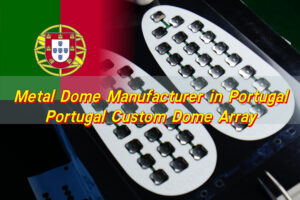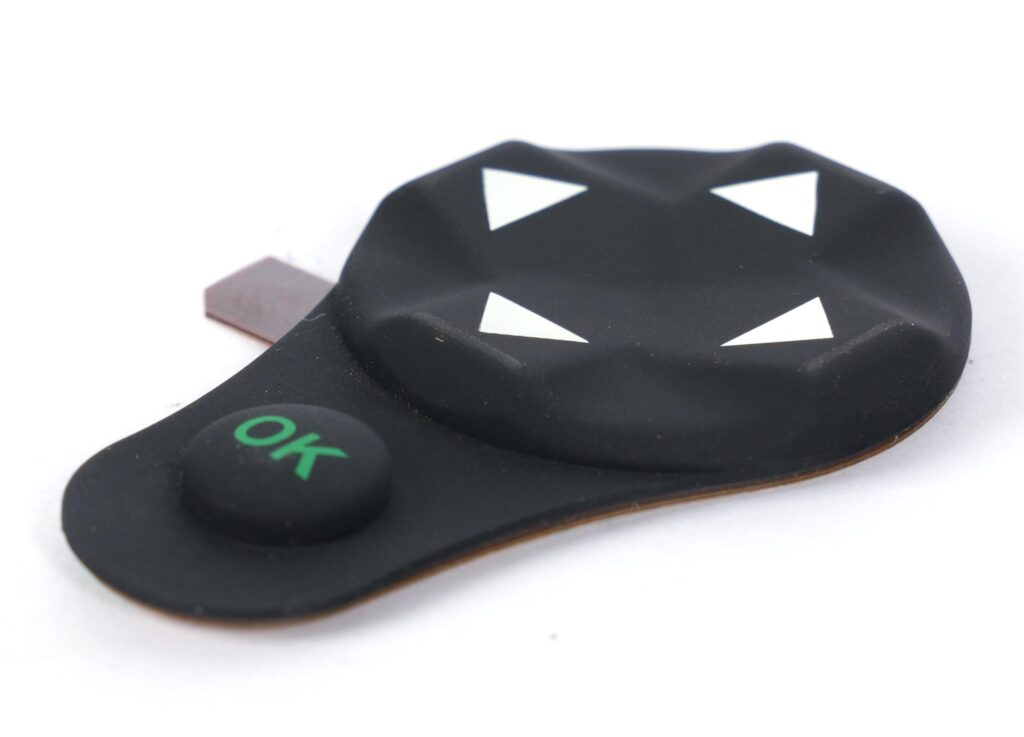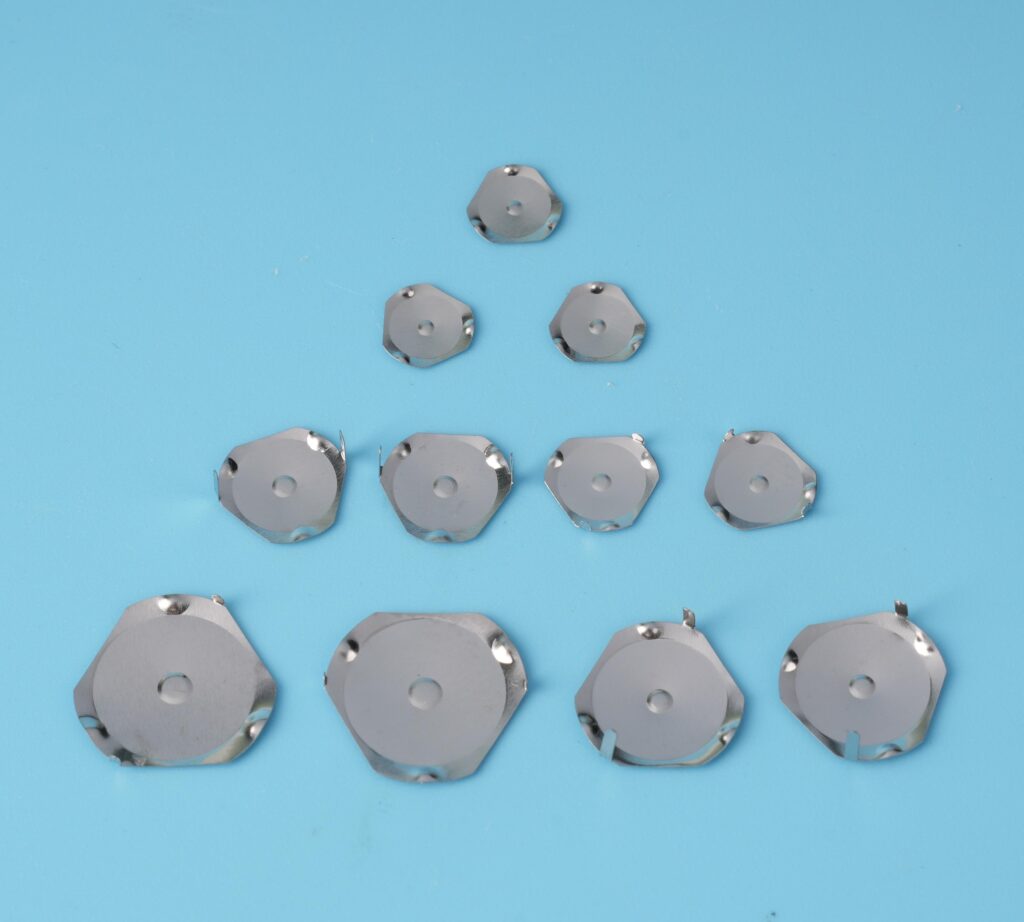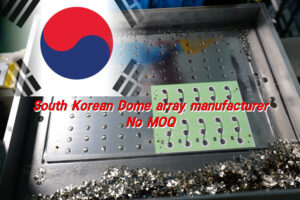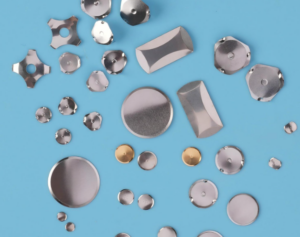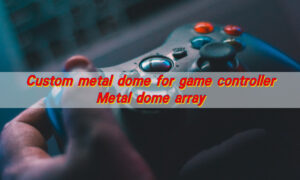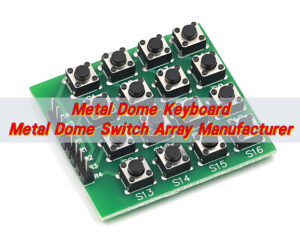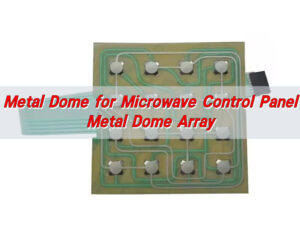Dome switch is a switch device that uses the elastic deformation of a metal dome to switch the circuit on and off. It is usually composed of a metal dome, a contact point, a housing, and a connection terminal. It can deform when subjected to external force and quickly return to its original state after the external force disappears.
What is a dome switch?
A dome switch is a switch that uses a metal dome to achieve the on-off function. When the switch is pressed, the metal dome deforms, turning the circuit on or off, thereby realizing the switch function.
The main components of a dome switch include an insert, a base, a dome, a button, and a cover. When the button is pressed, the dome deforms, contacts the circuit, forms a loop, and makes the switch work. The dome is usually made of stainless steel 301 or 304, which is corrosion-resistant and wear-resistant.
Dome switches are widely used in various electronic devices, such as audio-visual products, digital products, remote controls, communication products, household appliances, security products, etc.
What is a tactile dome switch?
A tactile dome switch is an instant-response device that senses operation through touch. The core function of a tactile switch is to connect an electrical circuit when the user applies slight pressure, while giving the user a clear and tangible “click” or tactile feedback. Once the switch is released, the flow of current stops.
A tactile dome switch consists of the following main parts:
Base: Provides a platform to support and connect the circuit board.
Dome (or contact spring): An elastic piece usually made of metal that provides contact force and ensures a stable electrical connection when the switch is pressed.
Button: The user activates the switch by pressing this part.
Contacts: Located under (or adjacent to) the dome, the dome makes contact with these contacts when the button is pressed.
Casing/cover: Protects the internal components and provides the appearance of the switch.
The working principle of a tactile dome switch is based on the metal dome inside it. When the user presses the switch, the center point of the dome is concave and contacts the circuit on the PCB, thus forming a loop, and the current passes through, so that the entire product can work normally.
Are rubber dome switches good?
Rubber dome switches have the following advantages and disadvantages:
Advantages:
Simple structure: The structure of the rubber dome switch is relatively simple, easy to manufacture and process, and low price.
High temperature resistance: The rubber material has a certain high temperature resistance and can remain stable within a certain temperature range.
Waterproof: The rubber material has good waterproof performance and is suitable for some environments that require waterproofing.
Sound insulation effect: The rubber material has a certain sound insulation effect and is suitable for occasions that require sound insulation.
Disadvantages:
Not resistant to high temperature and oil stains: The rubber material is not resistant to high temperature and oil stains, and is easily corroded and weathered, affecting the life and performance of the switch.
Natural frequency limit: The natural frequency of the rubber dome switch is low, which is difficult to meet some application scenarios that require high frequency response.
Unclear tactile feedback: Compared with metal domes, the tactile feedback of rubber domes is not clear enough, which may affect the accuracy of operation.
Are rubber dome switches tactile?
Rubber dome switches have tactile feel. Rubber dome switches use the deformation of conductive rubber to achieve the on and off state conversion of the switch, with a good feel and large contact resistance.
The working principle of rubber dome switches is to achieve the connection and disconnection of the circuit through the deformation of conductive rubber. When the button is pressed, the conductive rubber deforms, making the circuit connected; when the button is released, the conductive rubber returns to its original state and the circuit is disconnected. This deformation process will produce a certain tactile feedback, and the user can control the switch state of the circuit through the touch sensor.
The tactile feel of rubber dome switches is different from that of metal dome switches. Metal dome switches usually use the deformation of metal domes to achieve switch state conversion, with a good feel, a crisp “tick” sound when the button is pressed, small contact resistance, and precise operation. Although rubber dome switches also have a good feel, their contact resistance is large due to the physical properties of conductive rubber.
What is the difference between mechanical and dome switches?
Mechanical switches and dome switches differ in many aspects, as follows:
Structural composition
Mechanical switch:
Usually composed of housing, buttons, springs, contacts and other parts.
The housing protects and fixes the internal structure. The button is the part operated by the user, and the internal mechanism moves by pressing the button. The spring is used to provide the key recovery force to ensure that the button can bounce back to its original position after being pressed.
The contact is the key part to achieve the on-off of the circuit. When the button is pressed, the contact is closed and the circuit is turned on; when the button is released, the contact is separated and the circuit is disconnected.
Dome switch:
Mainly composed of metal dome, contact point, housing and connection terminal.
The metal dome is the core component, generally made of metal materials with good elasticity and conductivity, such as stainless steel, copper, etc. It has a specific shape, usually an arch or other elastic shape, which can be deformed when subjected to external force and quickly return to its original shape after the external force disappears.
The contact point is located under or around the shrapnel, and is used to achieve circuit conduction when the shrapnel is deformed. The shell protects the internal structure, and the connection terminal is used to connect to the external circuit.
Working principle
Mechanical switch: When the user presses the key of the mechanical switch, the key moves downward against the elastic force of the spring, pushing the internal mechanism to close the contact, thereby conducting the circuit. After releasing the key, the restoring force of the spring causes the key to rebound, the contact separates, and the circuit is disconnected. The working process of the mechanical switch mainly relies on the movement of the mechanical structure to achieve the on-off control of the circuit.
Shrapnel switch: When an external force acts on the shrapnel switch, the metal shrapnel undergoes elastic deformation, bends or moves toward the contact point, and contacts the contact point, thereby conducting the circuit. When the external force disappears, the metal shrapnel returns to its original state with its own elasticity, separates from the contact point, and the circuit is disconnected.
Why are mechanical switches better?
Clear sense of paragraph: Mechanical switches usually have a clear sense of paragraph during the process of pressing and releasing. During operation, the process of switching the switch from one state to another can be clearly felt, allowing people to clearly know whether the switch has been successfully turned on or off.
Obvious sound feedback: Mechanical switches often make sounds when they are in action. This sound feedback allows users to feel the action of the switch more intuitively during operation, and even if they don’t look at the switch, they can know whether the operation is successful.
Simple and stable structure: The structure of the mechanical switch is relatively simple, mainly composed of basic components such as the housing, buttons, springs, contacts, etc., without complex electronic components and circuits. It can maintain stable performance in various harsh working environments.
Long mechanical life: If high-quality materials and reasonable design are used, the mechanical life of the mechanical switch can be very long.
Strong adaptability to the environment: Mechanical switches can work normally under various environmental conditions such as temperature, humidity, and air pressure. Whether in a high-temperature industrial workshop, a humid basement, or in a high-altitude mountainous area, the mechanical switch can maintain stable performance.
Suitable for high-power equipment: Because the mechanical switch has good overload capacity and current bearing capacity, it is suitable for controlling high-power equipment. The mechanical switch can reliably realize the on and off of the circuit and ensure the normal operation of the equipment.
In short, as an important electronic component, the shrapnel switch plays an irreplaceable role in electronic equipment. With the continuous advancement of science and technology and the continuous expansion of application fields, the shrapnel switch is also constantly developing and innovating.


